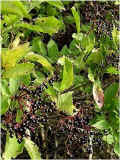| Greendykes House Hedgerow | |
|
Between Greendykes House and Greengables Nursery begins a mature hedgerow that goes right round to where the second channel of the Niddrie Burn disappears under ground. It is mainly Wych Elm, with some Hawthorn and Elder. Following the hedge into the corner (to the right of picture), there is a patch of Brambles and some Snowberry. |
|
|
Brambles, or blackberries, have been eaten and used medicinally for years. Wine, cordial and jam can be made from the berries, and tea from the leaves. The leaves were placed on swellings and burns, to soothe them, and a syrup made from the berries was used to relieve sore throats. The berries also give many colours of dye, from rose pink through to grey-blue and even orange. Pipes for smoking tobacco were traditionally made from bramble wood. Brambles provide a good shelter for birds, such as wrens and blackbirds. Insects eat the leaves and the blossoms attract bees and late spring butterflies. In August / September, the birds can also feed on the blackberries. |
|
Underneath these shrubs, there are lots of ground plants, including White Deadnettle, Red Deadnettle, Hedge Woundwort, Ground Ivy, Cleavers, Hogweed, Spear Thistle, Ivy, Stinging Nettle, Daisy, Lesser Celandine and several types of moss. And look out for tree-creeping birds in the bushes. |
|
From this corner, towards the flats and Greendykes Road, the hedge mainly consists of Hawthorn and some Elder, although it is now patchy, with a lot of gaps. Following the hedge to the front of Greendykes House, and beyond, there are two Sycamore trees standing alone in the mown grass, where there are also many molehills. The hedge meets the second channel of Niddrie Burn, where the burn disappears under ground. The vegetation then changes to being less hedge-like and there are more young trees and ground plants. Species alongside the burn include Ash, Alder, Norway Maple and Cherry trees with Yarrow and Common Reed in the ground layer. |
|
What to look out for and when: |
|||
| Spring | Summer | Autumn | Winter |
|
Glossy green leaves and yellow starry
flowers of Lesser Celandine
White blossom on the Hawthorn bushes Delicate, white Elder flowers White flowers on Brambles Butterflies and other insects on flowers White Deadnettle in flower Listen for gurgling Niddrie Burn. It goes under flats/fields hedgerow. Search for drain cover beneath BIG Hawthorn bush. Can hear it loudly there. Mounds of earth in short grass - molehills! Pigeons on sunny roofs of blocks of flats in Greendykes. Listen for field birds at ditch between two channels of Burn. E.g. Thrushes / Skylarks / Magpies / Crows. See if you can work out where their territories begin and end (by walking along hedge and seeing how far birds follow you). |
Pink/red
Red Deadnettle flowers
Small, shiny Redcurrant berries on bush at end of hedgerow between flats and fields. Black spots on Sycamore leaves (Tar Spot Fungus). Some leaves with green/red bobbles on ['galls' made by tree to surround Gall Mite eggs and larvae]. Butterflies (and wasps) on hogweed flowers. Bees and hoverflies on Dandelions in grass. Hedge Woundwort flowers: pinky-red orchid-like flowers with spots. Find under Elder and Hawthorn bushes between flats and fields. Smell the Himalayan Balsam next to Burn – very sweet – like fruit. Flowers are pink/white. Lots along Burn. Listen for buzzing bees and hoverflies. |
Bright red Holly berries
Red Hawthorn berries and jaggy thorns Yellow Ash 'keys' in clumps White Deadnettle in flower Ripe, dark purple Elder berries and red Elder leaves. Fluffy Thistle seed heads Ripe, black Brambles Hogweed skeletons and Ground-elder seed heads Birds feeding on berries – Rowan, Elder, Hawthorn, Holly, Yew and Brambles. Pink/purple Hedge Woundwort still in flower under bushes. Big, violet/blue flowers of Meadow Cranesbill (Geranium family) Bright red Rose hips Jews Ear fungus on Elder bushes Treecreepers going up thick, craggy trunks of old Hawthorn bushes, looking for insects Robins and Blackbirds Brown-lipped Banded Snails in twigs of Redcurrant bush. Beautiful Maple leaves along Burn. Green / yellow / red, turning to bright yellow. Some still have bunches of winged seeds |
White
Deadnettle may STILL be flowering!
Beginning of winter - look out for nests in trees (less leaves, so can see clearly). See if you can guess what bird used it from its size and neatness. Fantastic view over fields and up the hill, towards Danderhall Green/yellow Lichen on snail-bush (see autumn) with cup shapes Cones and catkins of Alder in between the Maple trees along the burn (by Greendykes flats). Listen to wind whistling through open stairwells and rustling leaves. Listen as go along burn – some parts louder than others. Some places, water gushing, some places quiet and sluggish cos of vegetation in it. Some places almost silent. Good view of Craigmillar Castle, Hawkhill Wood and Arthur’s Seat in distance. Also Greendykes Hedgerow running up to meet Hawkhill. |


